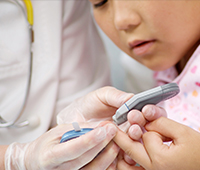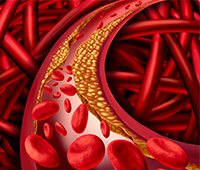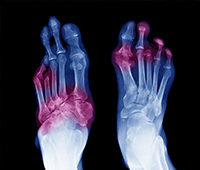WHAT IS Diabetes in children
- Definition
- Causes
- Symptoms
- Diagnosis
- Ayurvedic Tips
- FAQS
- References
Definition

Diabetes is a lifelong disease in which the blood sugar levels rise higher than normal. Until recently, children were mostly affected by type 1 form of diabetes (also called as juvenile diabetes) which is caused when the body is unable to make insulin- an important hormone for reducing excess sugar in the body. But this isn’t the case anymore. Increased numbers of children are now also getting type 2 form of diabetes, which is the most common diabetes in adults. Childhood obesity, bad lifestyle and poor diet are the main factors for causing this condition.2
In Ayurveda, diabetes is called madhumeha kshaudrameha, which means “excessive urine with sweet taste like honey”. The type 1 form of diabetes is called sahaja/jatah prameha and is mostly seen in children and thin people. The type 2 form of diabetes is called apathyanimittaja and is caused due to excessive habits such as improper diet and bad lifestyle, and is mostly seen is obese and overweight people, adults and children alike.
Ayurveda describes diabetes as one of the 20 types of urinary diseases or pramehas. These are classified based on the imbalance of predominant doshas of the individuals (10 due to kapha, 6 due to pitta and 4 due to vata), and physical appearance of urine.
Disclaimer: The information on this page is not intended to be a substitute for professional medical advice. Do not use this information to diagnose or ayurvedic treatment of diabetes and/or diabetes in children without consulting the doctor. Consult your physician before beginning an exercise regime. "While we have products /ayurvedic medicines for diabetes and/or diabetes in children, you must consult an authorized physician before taking any of the products. For more information on products, visit www.dabur.com or call 1800-103-1644"
Causes
Causes OF Diabetes in children
The exact cause of type 1 diabetes is unknown. But in most children, it is caused when body’s own immune system that normally fights harmful bacteria and viruses, mistakenly destroys the insulin-producing cells in the pancreas. Insulin’s role is to move the sugar from blood into cells, where it is stored and later used for energy. Lack of insulin causes high blood sugar and type 1 diabetes. Also, exposure to certain viruses is known to trigger the disease. Family history also plays a role in causing diabetes.
In children with type 2 diabetes, the cells of the body fail to respond correctly to insulin, eventually causing high blood sugar. Family history, hereditary factors, poor diet, low activity levels and excess body weight around the waist increase the chances of developing this type of diabetes.1
Ayurveda defines type 1 diabetes as a hereditary condition, which is caused due to genetic factors such as birth defects and is usually inherited from diabetic parents.5 Type 2 diabetes, on the other hand, is caused as a result of different diet or ahara practices, along with lifestyle or vihara habits such as:
- Sedentary lifestyle
- Excessive sleep
- Excessive intake of sweet, sugary, salty, difficult to digest and cold foods, and raw grains
- Regular consumption of seafood and meat
- Regular consumption of sugarcane juice and milk products
Disclaimer: The information on this page is not intended to be a substitute for professional medical advice. Do not use this information to diagnose or ayurvedic treatment of diabetes and/or diabetes in children without consulting the doctor. Consult your physician before beginning an exercise regime. "While we have products /ayurvedic medicines for diabetes and/or diabetes in children, you must consult an authorized physician before taking any of the products. For more information on products, visit www.dabur.com or call 1800-103-1644"
Symptoms
Symptoms OF Diabetes in children
Type 1 diabetes is more common in children and may present with some symptoms. Type 2 diabetes has no symptoms at first. Over time, they gradually begin. Common symptoms of both type 1 diabetes and type 2 diabetes include1:
- Excessive thirst and hunger
- Frequent urination
- Tiredness
- Weight loss
- Blurry vision
- Itchiness around the genital area
- Slow healing of wounds
- Frequent infections of bladder, kidney, skin, etc that heal slowly
Disclaimer: The information on this page is not intended to be a substitute for professional medical advice. Do not use this information to diagnose or ayurvedic treatment of diabetes and/or diabetes in children without consulting the doctor. Consult your physician before beginning an exercise regime. "While we have products /ayurvedic medicines for diabetes and/or diabetes in children, you must consult an authorized physician before taking any of the products. For more information on products, visit www.dabur.com or call 1800-103-1644"
Diagnosis
Diagnosis OF Diabetes in children
To diagnose diabetes and its type, the doctor may perform one or more of the following tests:
- Glycated hemoglobin (A1C) test: For type 1 and 2. It calculates average blood sugar level for the past 2-3 months
- Fasting blood sugar test: For type 1 and 2. It calculates blood sugar levels after an overnight fast (for at least eight hours)
- Oral glucose tolerance test: For type 2. It calculates fasting blood sugar level at empty stomach, followed by drinking of sugary liquid and blood sugar levels will be measured after 2 hours.
Disclaimer: The information on this page is not intended to be a substitute for professional medical advice. Do not use this information to diagnose or ayurvedic treatment of diabetes and/or diabetes in children without consulting the doctor. Consult your physician before beginning an exercise regime. "While we have products /ayurvedic medicines for diabetes and/or diabetes in children, you must consult an authorized physician before taking any of the products. For more information on products, visit www.dabur.com or call 1800-103-1644"
Ayurvedic Tips
Ayurvedic Tips Diabetes in children
To diagnose diabetes and its type, the doctor may perform one or more of the following tests:
- Glycated hemoglobin (A1C) test: For type 1 and 2. It calculates average blood sugar level for the past 2-3 months
- Fasting blood sugar test: For type 1 and 2. It calculates blood sugar levels after an overnight fast (for at least eight hours)
- Oral glucose tolerance test: For type 2. It calculates fasting blood sugar level at empty stomach, followed by drinking of sugary liquid and blood sugar levels will be measured after 2 hours.
Diet Recommendations (Aahar)
- Increase intake of barley in diet helps in drying up of excess fat / meda.
- Turmeric and cinnamon combination is beneficial in early stages of diabetes.
- Have herbs like gokshura, gudmar, triphalá, musta, cardamom, fenugreek, or coriander, mixed with honey.
- Include other cereals such as wheat, kodo millet and rice, which crops within 60 days to add fibre to diet.
- Pulses such as adhaki (Arahar), horse gram (kulattha), green gram (mudga), are beneficial.
- Include vegetables such as green banana, chaulee, dwarf copperleaf (matsyakhshi), methi (fenugreek leaves), bitter gourd, parawal, kunduru, lauki along with bitter and astringent leafy vegetables may be taken.
- Include fruits such as orange, watermelon, apple, jambu, kapitha, amla, papaya and other fruits with low sugar content.
- Soyabean, groundnut and mustard oil may be beneficial.
- Karela juice or white pumpkin 20-30 ml on an empty stomach may be beneficial.
- Regularly have methi seeds soaked overnight in water.
- Avoid sugar, sugar products, rice, potato, ghee, butter, fat, regular oil, fermented food items, alcohol, urad (blackgram), rajma (kidney beans) and other heavy items.
Lifestyle changes (Vihar)
- Start exercising regularly. Walking, swimming, running or yogasanas are excellent options.
- Have regular oil massage.
- Take regular steam.
- Include pranayama (breathing exercise) in the daily routine.
Disclaimer: The information on this page is not intended to be a substitute for professional medical advice. Do not use this information to diagnose or ayurvedic treatment of diabetes and/or diabetes in children without consulting the doctor. Consult your physician before beginning an exercise regime. "While we have products /ayurvedic medicines for diabetes and/or diabetes in children, you must consult an authorized physician before taking any of the products. For more information on products, visit www.dabur.com or call 1800-103-1644"
FAQS
FAQS
1. Can diabetes be prevented?
The two most common forms of diabetes are type 1 diabetes and type 2 diabetes. Currently, there is no way to prevent type 1 diabetes, but Ayurveda believes that making lifestyle and diet changes can reduce your risk of type 2 diabetes. These include exercising regularly, avoiding sugary and oily foods, minimising regular consumption of drinks such as beer, sugarcane juice and milk, and not sleeping too much.
2. What kind of meal plan is good for diabetes?
Controlling blood sugar levels will help you reduce your diabetes risk. You can achieve this by modifying your diet and including the following in your meals:
- Barley
- Herbs- gokshura, gudmar, triphalá, musta, cardamom, fenugreek, or coriander, mixed with honey
- Cereals- wheat, kodo millet and rice which crops within 60 days.
- Pulses- adhaki, horse gram (kulattha), green gram (mudga), along with bitter
- Vegetables- green banana, chaulee, dwarf copperleaf (matsyakhshi), methi (fenugreek leaves) and bitter gourd.
- Fruits- orange, watermelon, apple, jambu, kapitha and amla
3. I am a diabetes patient and I have developed a foot infection. How can Ayurveda help me manage this better?
Foot infections are very common in people with diabetes as high blood sugar levels reduce the blood supply to legs, making them more prone to all kinds of foot problems. If you do not take timely care of your foot, it could lead to serious complications and even amputation.
Ayurveda can help you manage your foot infections with a special treatment called shodhana therapy. This therapy purifies the body and expels the aggravated doshas from the body. It includes five procedures or panchakarma indicated for different types of doshas.
- Before panchakarma- palliative therapy using oil and sweating methods (snehana and svedhana) is performed.
- During panchakarma- the patient is made to go through emesis (vomiting), purgation (passing of stool), enema and nose therapy.
- After panchakarma- rejuvenation therapy is performed.
4. I have diabetes and lately I am experiencing blurry vision and pain in my eyes. What care can I take to manage my condition?
Eye problems are a very common complications of diabetes. When blood sugar levels become too high, diabetic people can get blurry vision leading to some common eye conditions like retinopathy, cataract and glaucoma.
Ayurveda can help you effectively manage your eye problems. It will not only reverse your problem but also make sure no future complications happen. There are a number of ayurvedic techniques that help improve blood circulation and provide nourishment to your eyes. These include:
- Applying lepa or ointment over eyes
- Netradhara: Pouring of herbal medicine in a weak stream through the inner corners of the eyes
- Takradhara: Pouring of buttermilk in a weak stream on the eyes
- Tharpanam: Hollow wells of black gram paste are gently sculpted around the eyes and medicated oil is poured in these wells
- Shirodhara: Gently pouring a medicated oil over the forehead
- Shirolepa: Application of a medicated paste (made up of herbs and medicinal powders) on the forehead
5. My child recently got diagnosed with type 2 diabetes, which is quite uncommon in children. What could be the causes?
In the past, children were mostly affected only by type 1 diabetes which is mainly caused due to genetic factors. But this isn’t the case anymore. Increased number of children are now getting affected by type 2 diabetes due to bad lifestyle habits, poor diet including junk food consumption and childhood obesity.
6. Is it common to get diabetes during menopause? If so, why?
It is true. Menopause in women increase their risk of diabetes, leading to many unique challenges. This is because during and after menopause, levels of estrogen hormone in the body decline. This hormonal imbalance causes women to experience increased hunger, increased body fat, reduced metabolism, hot flashes, night sweats, mood swings and vaginal dryness. Apart from these complications, the change in hormone levels also cause increase and decrease in blood sugar levels. For women who already have diabetes, this can lead to a number of health problems
7. What lifestyle changes does Ayurveda recommend for people with diabetes?
Certain lifestyle changes can go a long way in managing your diabetes, as they minimise your diabetes related complications and help you become healthy faster. Ayurveda recommends the following lifestyle habits:
- Exercise regularly. Cardio exercises such as walking, swimming and running help make your heart stronger and reduce your diabetes risk. Regular yoga is also known to be highly beneficial
- Have regular oil massages
- Take regular steam
- Taking sitz or waist bath (warm shallow bath to cleanse the genital area) also helps
- Include pranayama (breathing exercise) in your daily routine
8. I have pre-diabetes but I am worried that my condition may have moved to diabetes. Are there any red flags or warning signs to suggest that?
Pre-diabetes is a condition where your blood sugar level is higher than normal, but not high enough to be diagnosed as full-blown diabetes. If proper care is not taken, pre-diabetes often develops to diabetes, typically within 5 years. Pre-diabetes usually has no signs or symptoms, but once your disease starts progressing to diabetes, some early warning signs may include:
- Increased thirst
- Frequent urination
- Tiredness
- Blurry vision
9. Is methi in diet good for diabetes? How should it be taken?
Methi or fenugreek (in English) seeds are very useful in diabetes. Eat methi seeds once or twice a day. You can soak them in water overnight, and they can be consumed by chewing, swallowing or in the form of a paste mixed with water.
10. What are some natural home remedies for diabetes?
- Mix turmeric with aloe vera gel (1 to 3 gms./.035 to .1 oz) and eat it twice a day
- Have karela juice or white pumpkin 20-30 ml on an empty stomach
- Have methi seeds soaked overnight in water once or twice a day
- Have herbs like gokshura, gudmar, triphalá, musta, cardamom, fenugreek, or coriander, mixed with honey once a day
11. I have high cholesterol with diabetes. How can Ayurveda help me manage it?
It is very common in people with diabetes to also have high cholesterol. According to Ayurveda, this is due to lack of exercises, intake of fatty foods, sleeping during daytime and improper functioning of thyroid glands. Ayurveda is very effective in controlling cholesterol levels in people with diabetes. It uses a holistic approach by combining diet, exercise and intake of herbal medicine practises. Ayurveda recommends the following diet and lifestyle changes to manage high cholesterol and diabetes:
- Intake of food that is light in nature and fat-free such as-
- Vegetables: Karela, Lemongrass, Fenugreek, carrot, broccoli, cabbage, cauliflower
- Fruits: Banana, apples, strawberry, pears
- Herbs: Gingko, Garlic, Jatamansi, Tulsi
- Extracts (Arka): Ajamoda, Arjuna, Ginger, Karela, Kalonji (black cumin), Kokam
- Oils: Coconut oil
- Seeds: Flax seed
- Pulses: Soyabean
- Regular exercises such as brisk walking, swimming, running and aerobics
- Pranayama (breathing exercises) and yoga should also be a part of daily routine
12. I have diabetes and lately I feel depressed all the time. Is it related to diabetes? If so, are there any home remedies that can help me manage it?
It is quite common in people with diabetes to also feel depressed. Depression usually develops in life-long diseases and in case of diabetes, it is caused due to high blood sugar. But fret not, Ayurveda can significantly help you manage your depression using these diet and exercise remedies.
- Have gruel for three days. It is combination of oats, wheat and flour/rice. Follow this with parched barley powder mixed in water for the next 3 days
- Regularly practise yoga. Some good yogasanas that can help deal with depression are tadasana, surya namaskar and bhujasana.
13. What steps can I take to lose weight to manage my diabetes?
Weight gain is both a cause and a complication of diabetes. Most people with type 2 diabetes are overweight or obese when first diagnosed, and therefore, one of the most efficient strategies to control diabetes is to reduce weight. This will not only minimise your diabetes related complications, but will also help you become healthy faster. Ayurveda recommends the following tips to help you manage your weight:
- Exercise for at least 30-60 minutes everyday
- Regularly indulge in cardio exercises such as walking, swimming, jogging, aerobics etc to improve your heart health
- Avoid sleeping during the day or being lazy
- Avoid alcohol intake
- Adopt yoga as a part of your exercise regime. Certain yoga postures are known to stimulate pancreas (organ that makes insulin) and improve its function leading to better management of diabetes. Some yoga poses that are good for diabetics are kati chakrasana, vakrasana, tadasana, ustrasana, pranayama and surya namaskar
14. Should I stop eating honey if I want to control my blood sugar levels?
Many diabetics feel that they should quit both sugar and honey if they want to lower their blood sugar and control diabetes. Honey, however, is not harmful in diabetes as long as you moderate how much you are consuming in a day and distribute it throughout the day, instead of eating it all at once. After a meal, the stomach empties slowly and that’s why it is usually advisable to eat honey after a meal, as it not raise your blood sugar as much.
15. Is there any special diet in Ayurveda for controlling eye problems that arise from diabetes?
Ayurvedic treatment for eye problems focusses on both reversing the symptoms and strengthening the eyes by improving blood circulation and providing nourishment. Diet rich in Vitamin A will be very helpful in controlling eye problems. These include:
- Fruits like black grapes, pomegranate, and banana
- Vegetables like gooseberry, bitter gourd, snake gourd, elephant yam, green carrot, radish, and small bringal
16. Are there different Ayurveda treatments for diabetics that are overweight versus those that are thin?
Ayurveda treatment focusses on an entire change in the lifestyle of the person. The physical structure or body type is very important as the therapies will differ based on that. For overweight people, the main aim of Ayurveda treatment is to reduce fat and eliminate harmful toxins from the body. That is why the treatment includes cleansing procedures such as panchakarma. On the other hand, for thin people, the main aim of Ayurveda treatment is to improve immunity and provide nutrients to prevent further damage from diabetes. That is why the treatment includes more of nourishing procedures and only mild cleansing procedures.
Disclaimer: The information on this page is not intended to be a substitute for professional medical advice. Do not use this information to diagnose or ayurvedic treatment of diabetes and/or diabetes in children without consulting the doctor. Consult your physician before beginning an exercise regime. "While we have products /ayurvedic medicines for diabetes and/or diabetes in children, you must consult an authorized physician before taking any of the products. For more information on products, visit www.dabur.com or call 1800-103-1644"
References
References
- Type 2 diabetes. Medline Plus. 2015. https://medlineplus.gov/ency/article/000313.htm
- Diabetes in Children and Teens. Medline Plus. https://medlineplus.gov/diabetesinchildrenandteens.html
- Type 1 diabetes. Medline Plus. 2015. https://medlineplus.gov/ency/article/000305.htm
- Type 1 diabetes. American Diabetes Association. http://www.diabetes.org/diabetes-basics/type-1/?referrer=https://www.google.co.in/
- Purkait P. Prameha and its ancient ayurvedic medicine in India. Jr. Anth. Survey of India, 61 : 2 (659-669), 2012
- Mishra LC. Scientific Basis for Ayurvedic Therapies. 2004: MA; CRC Press
- AYurvedic approach to some selected diseases. Central Council for Research in Ayurveda and Siddha Department of Ayurveda, Yoga & Naturopathy. Ministry of Health and Family Welfare. 2009.
- Tirtha SS. The Ayurveda Encyclopaedia: Natural secrets to healing, prevention and logetivity. 2005;USA:Ayurveda Holistic Center Press
- Type 1 diabetes- Symptoms. NHS. 2014. http://www.nhs.uk/Conditions/Diabetes-type1/Pages/Symptoms.aspx
- Srikanth S. Diabetes Mellitus (Madhumeha) and AYurvedic Management: An Evidence Based Approach. World Journal of Pharmacy and Pharmaceutical Sciences. 4:8 (881-892)
- Lee MS, et al. Turmeric improves post-prandial working memory in pre-diabetes independent of insulin. Asia Pac J Clin Nutr. 2014;23(4):581-91.
Disclaimer: The information on this page is not intended to be a substitute for professional medical advice. Do not use this information to diagnose or ayurvedic treatment of diabetes and/or diabetes in children without consulting the doctor. Consult your physician before beginning an exercise regime. "While we have products /ayurvedic medicines for diabetes and/or diabetes in children, you must consult an authorized physician before taking any of the products. For more information on products, visit www.dabur.com or call 1800-103-1644"




